Page 204 of 426
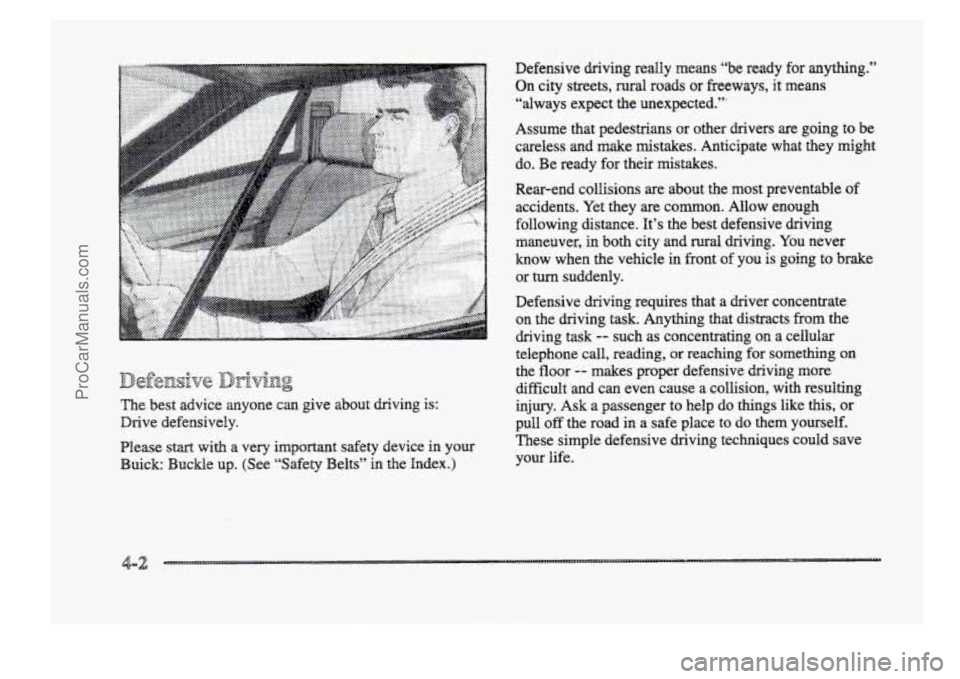
The best advice anyone can give about driving is:
Drive defensively.
Please
start with a very important safety device in your
Buick: Buckle up. (See “’Safety Belts” in the Index.) Defensive driving
redly means “be ready
for mything.”
On city streets, rural roads or freeways, it means
“always expect
the unexpected.”’
Assume that pedestrians or other drivers are going
to be
careless and make mistakes. Anticipate what they might
do. Be ready for their mistakes.
Rear-end collisions
are about the most preventable of
accidents.
Yet they are common. Allow enough
following distance. It’s the best defensive driving
maneuver, in
both city and wd driving. You never
know when
the vehicle in front of you is going to brake
or suddenly.
Defensive driving requires that a driver concentrate
on the driving task. Anything that distracts from the
driving task
-- such as concentrating on a cellular
telephone call, reading, or reaching for something
on
the floor -- makes proper defensive driving more
difficult and can even cause a collision, with resulting
injury.
Ask a passenger to help do things like this, or
pull
off the road in a safe place to do them yourself.
These simple defensive driving techniques coukl save
your Me.
4-2
ProCarManuals.com
Page 214 of 426
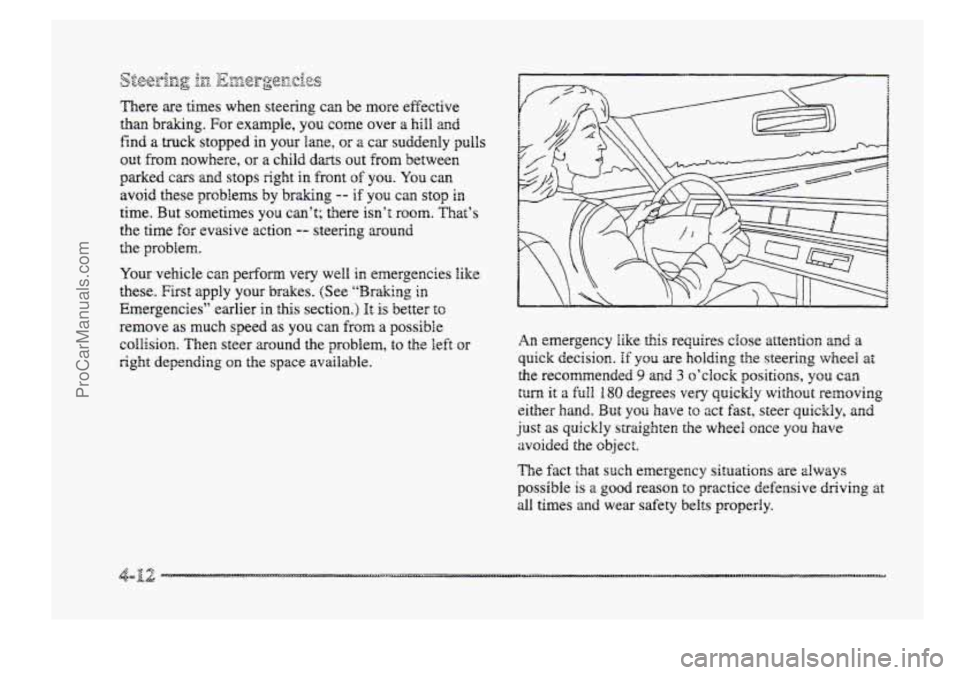
&3g;-izg 1x1 0 &i&rpe[z.iQs 7,ww e?
There are times when steering can be more effective
than brakmg. For example, you come over a hill and
find a truck stopped in your lane, or a car suddenly pulls
out from nowhere, OH a child darts out from between
parked
cars md stops right in front of YOU. You can
avoid these problems by
braking -- if you can stop in
time. But sometimes you can’t; trlere isn’t room. That’s
the time
for evasive action -- steering ~ound
the problem.
Your vehicle can perform very well in emergencies like
these. First apply your brakes. (See ‘‘Braking in
Emergencies” earlier in ”s section.) It is better tc
remove as much speed as you can from a possible
collision. Then steer around the problem, to the left or
right depending on the space available.
An emergency like this requires close attention and a
quick decision. If you are holding the steering wheel a’:
the recomended 9 and 3 o’clock positloas, you can
tuna it a full 180 degrees very quickly without removing
either hand. But you have to act fast, steer quickly, and
just as quickly straighten the wheel once you have
avoided the
object.
The fact that such emergency situations are always
possible is a good reason to practice defensive driving at
dl times and wear safety belts properly.
ProCarManuals.com
Page 286 of 426

Your vehicle may have 2 3800 Sqercharged engine.
Supercharging, rather
than turbocharging, emphasizes
smooth, refined power.
The supercharger is a device which is designed to pump
more ais into the engine than it would normally use.
This air mixed with fuel creates increased engine power.
Since the supercharger
is a pump and is driven from an
engine
accessory drive belt, iwreased pressure is
available at all driving conditions.
The Powertrain Control Module (PCM) works with a
vacuum control to regulate the increased pressure
required during specific driving conditions. When this
increased pressure or boost is not desired, such as during
idling and light tfarsttIe cruising, the excess air that the
supercharger is pumping is routed through a bypass.
AB1 sf these controk working together provide high
performance character and fuel efficiency in the
3800 V6 Supercharged engine.
The power steering pump and reservoir are mounted on
the rear (driver’s side) sf the engine biock. See
“Maintenance Schedule”
in the Index for when you
should check the fluid.
c
ENGINE OIL LOW CHECK LEVEL HMBHBMrn
Ef you have the Driver Infcmation Center, an ENGINE
OIL LOW-CHECK LEVEL message will appear when
the engine oil is approximately I quart (fL) Isw. 11 the
message is displayed, check the dipstick level and add
oil as needed.
7r
ProCarManuals.com
Page 345 of 426
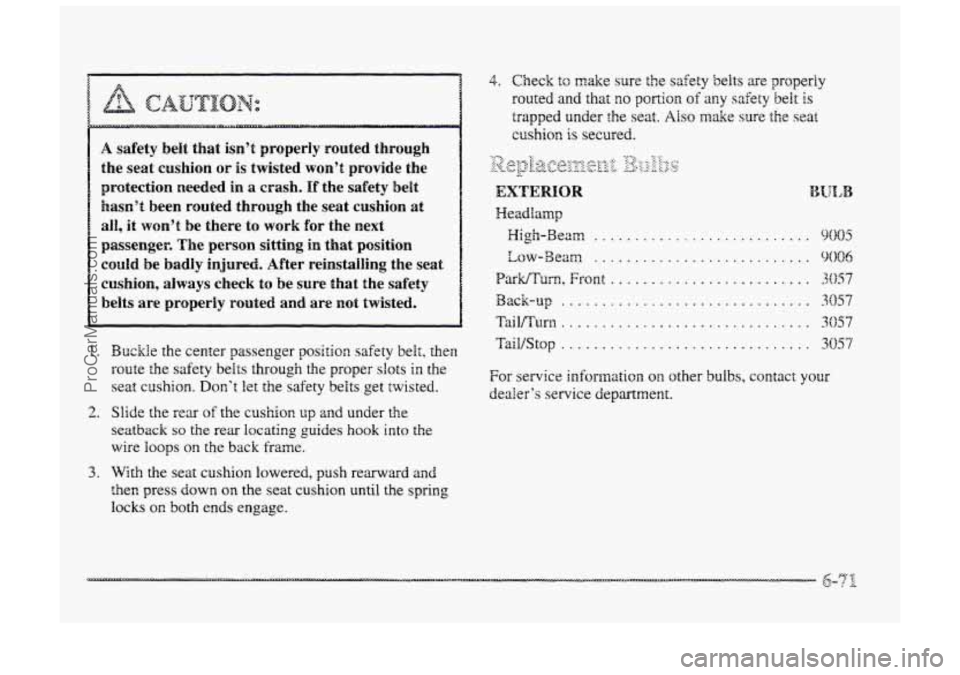
4. Check to make sure the safety belts are properly
routed
and that no p~rtion of any safety belt is
trapped under the seat. Also make sure the seat
cushion is secured.
A safety belt that isn’t properly routed through
the
seat cushion or is twisted won’t provide the
protection needed
in a crash. If the sa€ety beit
hasn’t been routed through the seat cushion at
all, it won’t be there to work for the next
passenger. The person sitting
in that position
couId be badly injured. After reinstalling the seat
cushion, always check to be sure that the safety
belts are properly routed and
are not twisted.
I.
2.
3.
Buckle the center passenger position safety beE:, then
route the safety belts though
the proper slots in the
seat csshion. Don’t let the safety belts get twisted.
Slide the rear
of the cushion up and under the
seatback so the rear locating guides hook into the
wire loops
on the back frame.
With the seat cushion lowered, push rearward
and
then press down on the seat cushion until the spring
locks on both ends engage.
EXTERIOR BBJIAB
Headlamp
High-Beam ........................... 9005
Zow-Beam ........................... 9006
ParWTum, Front ......................... 3057
Back-up ............................... 3057
Tai1Rtu-n ............................... 3057
TaiVStQp ............................... 3857
For service information on other bulbs, contact your
dealer’s service department.
ProCarManuals.com
Page 346 of 426
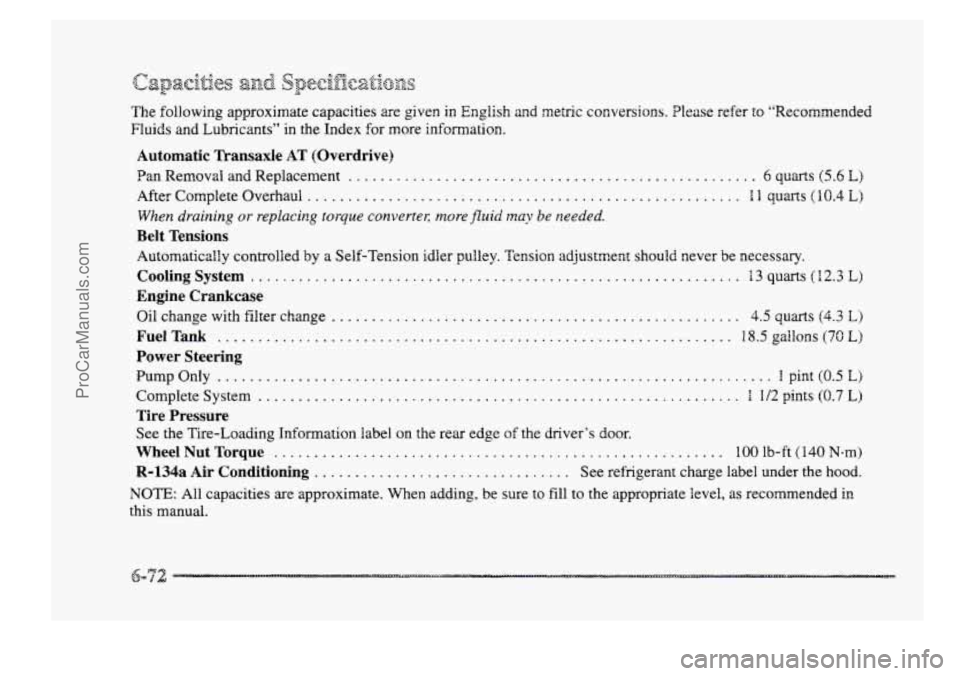
The following approximate capacities are given in English and metric conversions. Please refer to “Recommended
Fluids and Lubricants” in the Index for more information.
Automatic Transaxle AT (Overdrive)
Pan Removal and Replacement ................................................... 6 quarts (5.6 L)
After Complete Overhaul ...................................................... 1 I quarts (10.4 E)
When draining or replacing torque convertep; nzore fluid may be needed.
Belt Tensions
Automatically controlled by a Self-Tension idler pulley. Tension adjustment should never be necessary.
Cooling System ............................................................. 13 quarts (12.3 k)
Engine Crankcase
Oil change with filter change ................................................... 4.5 quarts (4.3 L)
Power Steering
Complete System ............................................................ 1 1/2 pints (0.7 L)
Tire Pressure
See the Tire-Loading Information label on the rear edge of the driver’s door.
WheelNutTorque ........................................................ 1001b-ft(140N-m)
R-134a Air Conditioning ................................ See refrigerant charge label under the hood.
FuelTank ................................................................ 18SgaIlons(70L)
PumpOnly ..................................................................... 1pint(OSE)
NOTE: All capacities are approximate. When adding, be sure to fill to the appropriate level, as recommended in
this manual.
ProCarManuals.com
Page 348 of 426

Qverall
Length ................. 206.8 inches (525.3 cm)
Width ................... 74.7 inches ( B 89.7 cm)
Height ................... 58.8 inches (147.6 cm)
Wheelbase .............. B 13.8 inches (289.1 cm)
Front Tread ............... 62.7 inches (159.3 cm)
Rear Tread ............... 62.3 inches (158.2 cm)
".. - ?$ ~.p~~~$ 5 ~~4a~~.~ena~~~~ T:. '..
17. ~~~~ja-aee~~~~~~~ , ..-. yay&
Engine Oil Filter ................ AC Type PF-47
_L
Air Cleaner Element .......... AC Type A- 1096C
Fuel Filter .................... AC Type GF-627
Spark Plugs ................... AC Type 41-921
Gap: 0.060 inch (. 152 crn)
Windshield Wiper Blades
Type
............................ Hook Style
Length
..................... 22 inches (56 cm)
Filter
(HVAC air filter) ..... GM Part No. 52472175
Passenger
Compartment
Air
&g&ze &yggsGyy 15 jL2Q e. ,.', E c/ I'
The 3800 (L36) engine uses an engine accessory belt.
This diagram shows the features connected by the belt
routing. See "Maintenance Schedule" in the Index for
when to check the belt.
A
C
A. Power Steering
B. Generator
C. Air Conditioning
D. Crank
E. Coolant Pump
E Tensioner
ProCarManuals.com
Page 349 of 426
1. Front Belt C. Crank
2. Back Belt D. Supercharger
A. Generator E. Coolant Pump
B. Power Steering IF. Air Conditioning The Supercharged
3800 engine
uses two accessory drive
belts. One belt drives the generator, power steering
pump, coolant
pump surd air conditioning compressor.
The second belt drives the superchwger. Each belt has
its own tensioner
mi idler pulley. See ‘‘Maintenance
Schedule” in the Index
for when to check he accessory
drive belts and supercharger oil level. Have your dealer
check the
oil level in the supercharger.
ProCarManuals.com
Page 355 of 426
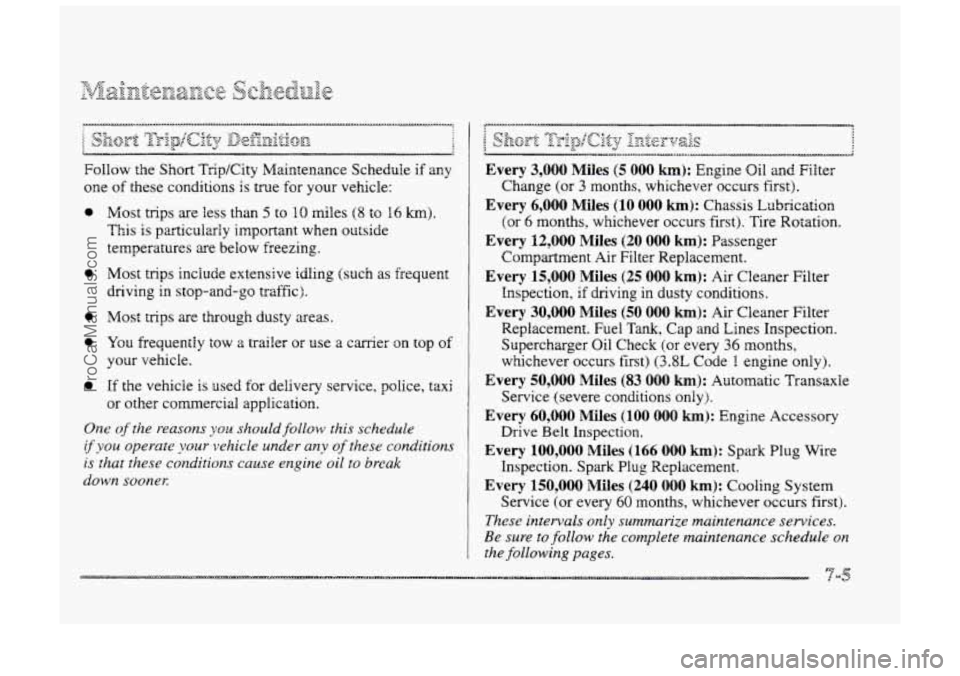
i ~~
Follow the Short Trip/City Maintenance Schedule if any
one of these conditions
is true for your vehicle:
0
0
0
0
0
Most trips are less than 5 to 10 miles (8 to I6 km).
This is particularly important when outside
temperatures are below freezing.
Most
trips include extensive idling (such as frequent
driving
in stop-and-go traffic).
Most trips are through dusty areas.
You frequently tow a trailer or use a carrier on tog of
your vehicle.
If the vehicle
is used for delivery service, police, taxi
or other commercial application.
One of the reasons you should follow this schedule
if you operate your vehicle under any of these conditions
is that these conditions cause engine oil to break
down
soonep:
r---
ShQTt 7&+p/cigy &$-~~y& c .. 6 - I-
Every 3,000 Miles (5 000 km): Engine Oil md Filter
Every 6,000 Miles (10 000 km): Chassis Lubrication
Every 12,000 Miles (20 000 km): Passenger
Every 15,000 Miles (25 000 km): Air Cleaner Filter
Every 30,000 Miles (50 000 km): Air Cleaner Filter
Change (or
3 months, whichever
occurs first).
(or
6 mo-nth, whichever occurs first). Tire Rotation.
Compartment Air Filter Replacement.
Inspection,
if driving in dusty conditions.
Replacement. Fuel
Tank, Cap and Lines Inspection.
Supercharger
Oil Check (or every 36 months,
whichever occurs first)
(3.8L Code I engine only).
Every 50,000 Miles (83 080 km): Automatic Transaxle
Service (severe conditions only).
Every 60,000 Miles (100 000 km): Engine Accessory
Drive Belt Inspection.
Every 100,000 Miles (166 000 km): Spark Plug Wire
Inspection.
Spark Plug Replacement.
Every 150,000 Miles (240 000 km): Cooling System
Service
(or every 60 months, whichever occurs first).
These intervals only summarize maintenance services.
Be sure to follow the complete maintenance schedule on
the following pages.
RP I -3
ProCarManuals.com